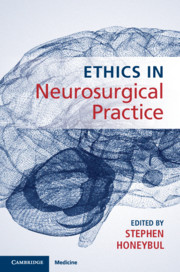Book contents
- Ethics in Neurosurgical Practice
- Ethics in Neurosurgical Practice
- Copyright page
- Contents
- Contributors
- Introduction
- Part I General Ethics
- Part II Neurosurgery-Specific Bioethics
- Chapter 10 A Historical Overview of Ethics in Neurosurgery
- Chapter 11 Evidence-Based Neurosurgery: Principles, Applicability, and Challenges
- Chapter 12 Ethical Challenges of Neurosurgical Care for Brain Tumour Patients
- Chapter 13 Severe Traumatic Brain Injury
- Chapter 14 ‘Malignant’ Middle Cerebral Artery Infarction
- Chapter 15 Aneurysmal Subarachnoid Haemorrhage
- Chapter 16 Paediatric Neurosurgery
- Chapter 17 Spinal Neurosurgery
- Chapter 18 Ethical Challenges in Psychosurgery: A New Start or More of the Same?
- Chapter 19 Brain Death and Organ Donation
- Part III Future Developments
- Index
- References
Chapter 16 - Paediatric Neurosurgery
from Part II - Neurosurgery-Specific Bioethics
Published online by Cambridge University Press: 29 May 2020
- Ethics in Neurosurgical Practice
- Ethics in Neurosurgical Practice
- Copyright page
- Contents
- Contributors
- Introduction
- Part I General Ethics
- Part II Neurosurgery-Specific Bioethics
- Chapter 10 A Historical Overview of Ethics in Neurosurgery
- Chapter 11 Evidence-Based Neurosurgery: Principles, Applicability, and Challenges
- Chapter 12 Ethical Challenges of Neurosurgical Care for Brain Tumour Patients
- Chapter 13 Severe Traumatic Brain Injury
- Chapter 14 ‘Malignant’ Middle Cerebral Artery Infarction
- Chapter 15 Aneurysmal Subarachnoid Haemorrhage
- Chapter 16 Paediatric Neurosurgery
- Chapter 17 Spinal Neurosurgery
- Chapter 18 Ethical Challenges in Psychosurgery: A New Start or More of the Same?
- Chapter 19 Brain Death and Organ Donation
- Part III Future Developments
- Index
- References
Summary
A thorough understanding of ethical issues, which are often encountered in the field of paediatric neurosurgery, can help neurosurgeons in decision-making regarding optimal treatment in children. Although ethical dilemmas in paediatric neurosurgical patients frequently share common characteristics with those seen in the management of adult patients, they also differ and are more complex. For example, because child patients do not have the ability to make decisions on their own due to their age, their parents are usually substitute decision makers. Ethical problems in paediatric neurosurgery may arise with prenatal diagnosis and continue to be encountered in various age groups with different characteristics during foetal, neonatal, infancy, playschool age, school age, and adolescence. Moreover, intrauterine foetal life involves the health and wellbeing of the mother, further complicating ethical decision-making. Collaborative communication and the exchange of information between the medical team and the family, which leads to a shared family-centered decision-making, are an increasingly preferred approach to paediatric medical decision-making. In addition, developmental maturation of the child allows for increasing longitudinal inclusion of the child’s opinion in medical decision-making in clinical and research practice. The child should always be informed in a respectful manner and using simple language adjusted to the childs age. Despite the limits of medicine at a specific time, clinicians should always respect a child with an incurable disease and show warm sympathy toward babies born with the fate of a short life.
- Type
- Chapter
- Information
- Ethics in Neurosurgical Practice , pp. 154 - 167Publisher: Cambridge University PressPrint publication year: 2020
References
- 1
- Cited by



